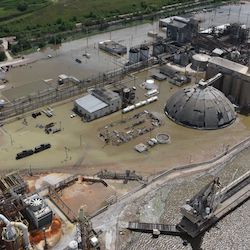SEJournal Online is the digital news magazine of the Society of Environmental Journalists. Learn more about SEJournal Online, including submission, subscription and advertising information.
TipSheet: Is There a Post-Flood “Toxic Stew” Near You?
The havoc Hurricane Harvey caused included spills of toxic and pathogenic materials into the waters that pervaded much of Houston. This is an overlooked environmental story — overlooked partly because governments and companies don’t want people to know about it.
But scoops were had and fuss followed. The U.S. Environmental Protection Agency attacked Associated Press reporters for reporting onsite about flooded Superfund sites ... while EPA was nowhere to be found. Of course, the AP team was doing just the kind of journalism environmental reporters are supposed to do. That’s all another story.
The bad news is that it will happen again. The good news is that environmental journalists almost anywhere can tackle similar stories.
Disasters, especially flooding disasters associated with hurricanes, happen all the time. And the disruption they cause often results in the release of bad stuff into the environment. It’s not just about Superfund hazardous waste sites, but also about sewage plants and systems, about petrochemical plants, and other industrial facilities handling toxic and hazardous materials.
Here are some particularly notable risks:
 |
| Aerial assessments were conducted over the ports of Houston, Texas City, Freeport and Galveston on Aug. 31, 2017, to identify damaged facilities, potential oil spills or chemical releases. Photo: U.S. Coast Guard/Petty Officer 1st Class Patrick Kelley. |
- Superfund sites. There are more than 1,300 “Superfund” hazardous waste sites in the United States, and those are just the worst ones. You can search the National Priority List of Superfund sites geographically online here. Most of these are already partly cleaned up, but may still be vulnerable to flooding.
- State hazardous waste sites. Most states have their own cleanup programs and these programs compile lists of contaminated sites that may be at risk. There is a list of state hazardous waste cleanup programs here. EPA has thoughtfully put online here a list of some other databases that may lead you to at-risk sites. Check your state agency for lists.
- Underground storage tanks. There are some 558,000 underground storage tanks in the United States containing petroleum or other hazardous substances. These are vulnerable in floods and many are being cleaned up. State agencies often have lists of them. Here are examples for Michigan, Maryland and Arizona. Check with your state environmental agency.
- Brownfields. Brownfields are less-severely polluted waste sites that have been mostly cleaned up and repurposed or redeveloped. Even though they should not be problematic in a flood, they might. You can find some lists of brownfields here and local info here, or check with your state agency.
- Sewage treatment plants. Sewage plants, often located in low-lying areas near water, are frequently knocked out by severe floods. This means raw sewage, loaded with pathogens and pollution, will be discharged into waterways and even flood waters. If you don’t know where your local sewage treatment plants are, try looking here. Google has a map of most U.S. plants online here.
- Petrochemical plants. Refineries and chemical plants come in many varieties. And many batten down the hatches or shut off during the worst storms. Shutdown and startup operations often spew high amounts of pollution into the neighborhood. And flood waters may transport disaster-related spills and leaks over a large area. No one list is a silver bullet, but you can focus on a specific geographic area in EPA’s Facility Registry Service, searchable here and in the form of raw data here.
And here are some suggested starting points for your localized reporting.
- National Response Center. The law requires almost anyone who spills toxic or hazardous substances into U.S. waterways to report the incident to the National Response Center, which is run by the Coast Guard. In a Sept. 19 scoop, Michael Biesecker and an AP crew got call logs from the NRC hotline, and based a story on the spill info therein. If you knew what you were looking for, you might do the same.
- Bottle (and test) your own. When government agencies won’t disclose toxic releases, enterprising journalists sometimes do their own sampling, monitoring and analysis. Awards have been won by such projects, but they may be hard to mount in the rush and chaos of a disaster. A New York Times team pulled it off in a Sept. 11 post-Harvey story — partly by collaborating with experts at local universities.
- Call the agency. While federal agencies are often stingy with information, it might help. Try calling the EPA regional office to ask for the “on-scene coordinator” for your incident. Or call the Coast Guard to ask if they have set up a “unified command.” Even if it just rings through to a non-helpful public affairs flunky, it is worth a shot.
* From the weekly news magazine SEJournal Online, Vol. 2, No. 36. Content from each new issue of SEJournal Online is available to the public via the SEJournal Online main page. Subscribe to the e-newsletter here. And see past issues of the SEJournal archived here.














 Advertisement
Advertisement 



